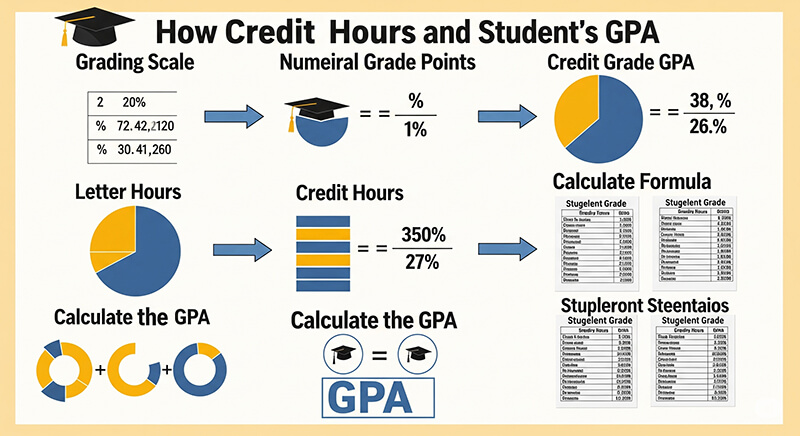Key Takeaways
| Feature | Description | Main Point |
|---|---|---|
| What It Is | A letter-grade heat map is a chart that uses colors to show how often different grades (A, B, C, etc.) are given in a course. | Bright, "hot" colors (like red) show grades that are given out a lot, while "cool" colors (like blue) show grades given out less often. |
| Course Selection | Students can look at heat maps for different classes to see grading patterns before they register. | A heat map might show if a class tends to have more A's and B's or more C's and D's. |
| Spotting Trends | Heat maps can show how grading has changed over many years, a trend known as grade inflation. | Data shows that A's are now the most common grade, a significant change from past decades. |
| Personal Planning | You can use the idea of a heat map to track your own grades and see where you are doing well or need to improve. | Visualizing your own grades helps you set realistic goals and plan your academic path. |
| Data Privacy | The data in these heat maps is always anonymous to protect individual student privacy. | Schools have strict rules, like FERPA, to ensure personal grade information is not shared. |
What is a Letter-Grade Heat Map?
A letter-grade heat map is a special kind of chart. It uses colors to show you information about grades. Think of it like a weather map. On a weather map, red means hot and blue means cold. On a grade heat map, bright colors like red and orange show which letter grades are given most often in a class. Cooler colors like blue show grades that are not as common. This makes it very easy to see the grading patterns in a course at a single glance. You can learn more about the basics of grades and GPA with a helpful GPA calculator guide.
How to Read a Grade Heat Map
Reading a heat map is simple. The chart is a grid. Courses are listed on one side, and letter grades (A+, A, A-, B+, etc.) are listed across the top. Each box in the grid has a color. The color tells you the percentage of students who earned that grade in that class. A dark red box in the "A" column for "MATH 101" means a large number of students got an A. A light blue box in the "C-" column means very few students got a C-. This visual tool helps you see trends, which you can also track with a GPA trend graph generator.
Seeing Grade Inflation Over Time
Heat maps are great for seeing changes over many years. One big trend in education is grade inflation. This means that the average grades given to students have been going up over time. In the past, a C was the most common grade on college campuses. Today, an A is the most frequent grade awarded at most four-year colleges. A heat map from the 1990s would look very different from one today. You can learn more about this topic by reading about GPA inflation vs. deflation.
Choosing Courses with Data
Students can use heat maps to make smarter choices about which classes to take. By comparing the heat maps for different courses, you can see the typical grade distribution. This can help you understand the academic challenge of a course before you enroll. For example, you can see the difference in grading between your main subjects and optional classes by using a core vs. elective GPA calculator. This information is also useful when planning for required classes with a prerequisite-only GPA calculator.
Analyzing Your Own Academic Performance
You can apply the idea of a heat map to your own grades. By creating a visual chart of your grades, you can quickly see your strengths and weaknesses. This can help you understand your overall standing, which is also what a cumulative GPA calculator does. For a more focused view, a semester GPA calculator can show you how you did in a specific term. This personal heat map helps you track your progress and set goals for the future.
Planning Your Academic Future
Heat maps are not just about looking at past grades; they are also for planning. They can help you set realistic expectations for future courses. When you are just starting college, a freshman year GPA predictor can help you aim for a strong start. As you go through a semester, a mid-term grade projection slider can help you estimate your final grades based on your current performance. These tools, combined with the insights from heat maps, give you more control over your academic journey.
Heat Maps for Complex Academic Paths
Students in special programs can also benefit from grade data. If you are thinking about switching your field of study, a major change GPA impact tool can show you how that might affect your GPA. For those earning two degrees at once, a dual-degree gpa splitter helps manage grades for both programs. Even students studying in other countries can use a study abroad grades gpa integrator to understand how their international grades will be viewed.
Understanding Different Grading Systems Visually
Heat maps can also help make sense of different grading systems from around the world. Whether a school uses percentages, a 12-point scale, or the IB system, a heat map can show the grade distribution in a simple, visual way. This is helpful when you need to understand various scales, such as with a percentage to 4.0 GPA conversion guide or a 12-point to 4-point scale chart. For students in specific programs, an IB to GPA conversion guide is also a useful resource.
Using Heat Maps to Avoid GPA Errors
Visualizing grade data can also help you spot potential mistakes in your own records. When you see your grades laid out in a chart, an error might stand out more clearly. To prevent issues, it is good to know the common GPA calculation errors to avoid. Regularly reviewing your academic record is also a smart habit. A transcript GPA audit guide can walk you through the process of checking your transcript for accuracy.
The Big Picture: How Schools Use Grade Data
Schools and universities use grade distribution data to improve their programs. By looking at heat maps, administrators can see which courses might be too difficult or too easy. They can also understand how grading standards differ across departments. This information helps them make sure that grading is fair and consistent. A guide on how school districts calculate GPA can provide more insight into how these decisions are made at a broader level.
Frequently Asked Questions (FAQ)
What is a letter-grade heat map? A letter-grade heat map is a chart that uses colors to show the distribution of grades (A, B, C, etc.) in different courses. Hot colors like red mean a grade is given frequently, while cool colors like blue mean a grade is given less often.
Can I use a heat map to find "easy" professors or courses? Heat maps show past grading patterns, which can give you an idea of a course's typical grade outcomes. However, they do not capture factors like course difficulty, teaching quality, or your own personal interest in the subject. They are one tool among many to help you select courses.
Where does the data for grade heat maps come from? The data comes from official, anonymous grade records from the educational institution. Schools collect this data and may share it in an aggregated form to provide insights into academic trends.
Are letter-grade heat maps a violation of student privacy? No. The data used in heat maps is always anonymized. This means all personal information is removed, and the data is presented in a way that no individual student can be identified. This practice complies with privacy laws like FERPA.










